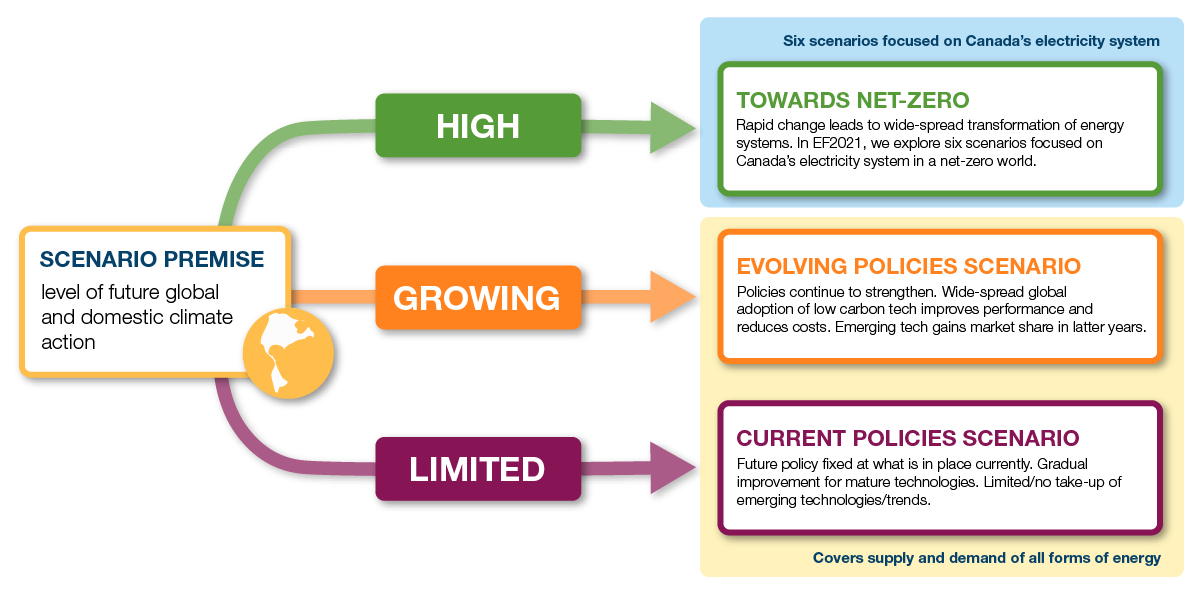The CER has issued an errata to correct several errors in the report
Executive Summary

Overview and Background
The Canada’s Energy Future series explores how possible energy futures might unfold for Canadians over the long term. Canada’s Energy Future 2021: Energy Supply and Demand Projections to 2050 (EF2021) is our latest long-term energy outlook. The outlook covers all energy commodities and all Canadian provinces and territories, and makes projections using economic and energy models. We also make assumptions about technology, energy and climate policies, energy markets, human behaviour, and the economy.
In the long term, global and Canadian ambition to reduce greenhouse gas (GHG) emissions will be a critical factor in how energy systems evolve. EF2021 considers two main scenarios where energy supply and demand projections differ based on the level of future actionFootnote 2 to reduce GHG emissions. EF2021 also includes six additional scenarios that explore what Canada’s electricity system might look like in a net-zero world. The two main scenarios include projections for all energy commodities, whereas the six electricity scenarios focus only on how Canada will meet given electricity demands under different conditions.
The first main scenario in EF2021 is the Evolving Policies Scenario. The premise of this scenario is that action to reduce GHG emissions from our energy system continues to increase at a pace similar to recent history, in both Canada and the world. Relative to a scenario with less action to reduce GHG emissions, this projection implies less global demand for fossil fuels, and greater use of low-carbon technologies. The second main scenario is the Current Policies Scenario, which assumes limited action to reduce GHGs beyond policies in place today.

These scenarios do not explicitly model climate goals or targets. Instead, we make assumptions based on the scenario premises and rely on the Energy Futures Modelling Framework to make long-term projections of energy supply and demand in Canada. Together, these scenarios provide insights into what the energy system might look like if action to reduce GHG emissions continues to grow at the pace it has in recent years, or if it were to stop at current levels.
Canada has committed to reducing its GHG emissions by 40 to 45% below 2005 levels by 2030 and achieving net-zero GHG emissions by 2050. Reducing emissions to these levels will likely require more change than we model in the Evolving or Current Policies scenarios. Therefore, EF2021 introduces six new scenarios that explore a net-zero future. Specifically, these scenarios explore what Canada’s electricity system might look like in a net-zero world under different assumptions about future technologies, climate policies, and electricity use. Electricity is expected to be an important contributor to achieving net-zero emissions, so these projections are an important step in modeling related to a net-zero energy system in the Canada’s Energy Future series.
Figure ES.1 provides a conceptual illustration of the two main scenarios included in EF2021, as well as the net-zero scenarios focused on electricity.
Figure ES.1: Illustration of EF2020 Scenarios

Description
Description: This figure provides an illustration of the scenario premises of EF2021. The first main scenario in EF2021 is the Evolving Policies Scenario. The premise of this scenario is that action to reduce GHG emissions from our energy system continues to increase at a pace similar to recent history, in both Canada and the world. Relative to a scenario with less action to reduce GHG emissions, this projection implies less global demand for fossil fuels, and greater use of low-carbon technologies. The second main scenario is the Current Policies Scenario, which assumes limited action to reduce GHGs beyond policies in place today. In addition, EF2021 introduces six new scenarios that explore a net-zero future with a high level of global and domestic climate action. Specifically, these scenarios explore what Canada’s electricity grid might look like in a net-zero world under different assumptions about future technologies, climate policies, and electricity use.
This Executive Summary highlights the key findings of EF2021. The “Scenarios and Assumptions” section outlines the specific assumptions used in the Evolving and Current Policies scenarios. The “Results” section provides an overview of the projections for the various parts of the Canadian energy system under our two main scenarios, with a focus on the Evolving Policies Scenario. The “Towards Net-Zero” section includes the first major net-zero modeling exercise of the Canada’s Energy Future series: six scenarios that examine the effect of different factors (e.g. technology, policies, level of electrification, infrastructure) on Canada’s electricity system in a net-zero world. Finally, the “Access and Explore Energy Futures Data” section provides links to access data, tools, and interactive data visualizations for further exploration of EF2021.

- Date modified:
